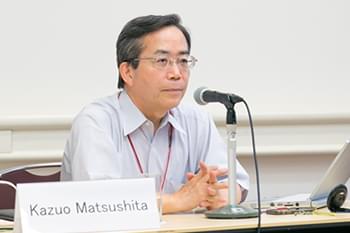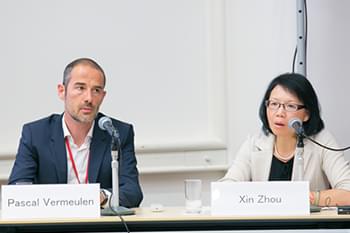| ISAP2016 Side Event |
|---|
Pathways to 2℃ by 2050: Key Messages from the Global Calculator
To answer the question as to whether it is possible to meet our 2-degree climate targets and ensure everyone has good living standards by 2050, experts from over ten leading international organisations came together to build a model of the world’s energy, land, food and climate systems. The team, led by the UK Department of Energy & Climate Change (DECC) and Climate-KIC, built the “Global Calculator” to model what lifestyle is physically possible - from kilometres travelled per person to calorie consumption and diet - and the energy, materials and land requirements to satisfy all this. The climate impacts of different pathways are also illustrated by linking the model to the latest IPCC climate science. Underscoring the significance of the Global Calculator in understanding the world’s long-term climate scenarios, IGES, with financial support from MOEJ and technical assistance from UK DECC, translated the Global Calculator into Japanese in 2015. The Japanese version will be useful for awareness-raising, educational purposes, business analysis, and for engaging informed dialogues on climate change-related issues facing the world and Japan.
Taking the opportunity of ISAP2016, we informed the audience of the launch of the Global Calculator in the Japanese language, and shared the key messages derived from it. Towards the end of the Day One Plenary Session on Actions to Combat Climate Change: Roles of Key Stakeholders (12 July 2016), IGES Senior Research Advisor Prof. Shuzo Nishioka announced the official launch of the Japanese version of the Global Calculator. Following the announcement, IGES Senior Fellow Prof. Kazuo Matsushita and CLIMACT Managing Director Mr. Pascal Vermeulen briefly talked about what the Global Calculator is, and why it is needed. At the same time, they invited the audience to attend an hour-long side event where the Global Calculator would be demonstrated along with the key messages and insights derived from it. The side event was arranged in the afternoon of the same day, and it was facilitated by Prof. Kazuo Matsushita. A brief summary of the side event is given below.
Introductory Remarks
Session Facilitator Prof. Kazuo Matsushita of IGES made the opening remarks, highlighting the current developments of global climate change policy processes. In particular, Prof. Matsushita noted the significance of the Paris Agreement for the world’s long-term emissions reduction strategies. To this end, he emphasised the importance of science-based, transparent, multi-stakeholder deliberations and objective tools such as the Global Calculator which enables quantitative tools that are useful for such deliberations.
Speakers's Presentations
Global Calculator expert Pascal Vermeulen (Managing Director, CLIMACT) introduced the Global Calculator tool to the audience. He explained what the Global Calculator is, what the principles behind the tool are, who can use the tool, and how the tool works. He further introduced the four options for setting the levels and what they mean using the wind power scenario setting as an example. Through a lively presentation combined with direct demonstration of the tool, Mr. Vermueulen also shared some of the key messages that are derived from the Global Calculator. He emphasised that attaining the 2-degree target without compromising a better life at the global level is physically possible but that it requires significant transformation in the technologies and fuels used for powering our life and economic growth and also requires smarter use of the land. He also explained how the Global Calculator can be used as a handy tool to help test out options, trade-offs and associated costs towards this journey. He concluded with several myth-busting questions including whether we can just switch from coal to gas, whether we can wait until we use up the fossil fuels we have, whether we can just absorb the carbon out of the atmosphere, and whether we can just curb population growth. With negative answers to all these questions he echoed back to the conclusions that the world’s inhabitants could eat well, travel more and live in more comfortable homes while preventing dangerous climate change but to do so, we need transformative changes in the technologies and fuels we use.
Dr. Xin Zhou (IGES) introduced the Japan 2050 Low Carbon Navigator tool to the audience. Like the Global Calculator, the Low Carbon Navigator also uses a 2050 Calculator model, but it is a national-level tool for Japan. This tool was developed by IGES and NIES with technical support from UK DECC and the British Embassy Tokyo. Dr. Zhou’s presentation started with an overview of the Low Carbon Navigator, its background and what type of questions it can address. Some new features of the tool focusing on Japan’s 3E+S (Energy Security, Economic Efficiency, Environmental Protection and Energy Safety) energy policy framework were also presented. Dr. Zhou also demonstrated the Low Carbon Navigator and explained its structure and level settings. She concluded with several key messages including the many pathways existing for Japan to achieve its long-term 80% reduction by 2050, the importance of the adoption of carbon capture and storage (CCS) technologies, the economic costs of renewable energy from long-term and short-terms views and the need for an integrated approach from both supply-side and demand-side efforts. The speakers’ presentations were followed by a lively Q&A session. There were queries and suggestions on how the calculator tool, both the global and the national level versions, could be helpful in awareness-raising among university as well as high school students. The speakers informed the audience about similar initiatives in the UK and Taiwan, and how Japan can take some ideas from these initiatives. Some of the audience suggested the development of a simpler version of the national level tool, which can be used even by elementary school students. A few companies showed interest in the tool, particularly for setting up enterprise-level targets using the tool (the national one). There were a few other questions relating to some good examples of using the tool for policymaking processes. Overall, the Global Calculator as well as the Japan 2050 Low Carbon Navigator generated quite a lot of enthusiasm among the audience, and it is expected that these tools will be helpful for a growing number of users.
(Reported by Dr. Mustafa Moinuddin, Green Economy Area, IGES)
| Date & Time | 12 July 2016, 15:30-16:30 | Language | English /Japanese |
|---|---|---|---|
| Venue | Room 511/512, Pacifico Yokohama Conference Center | ||












